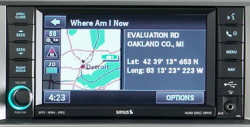First popular in Japan, navigation systems that are built into the vehicle have become a must-have option in the U.S. as well. Very common in luxury cars, they’re increasingly common in mainstream models. But do they even make sense?
The advantages of built-in navigation systems are clear: you get a larger screen, a cleaner installation, and less risk of theft.
 The disadvantages aren’t as clear, but could easily outweigh the disadvantages. First off, built-in navigation systems are expensive, costing at least $900 and sometimes over $2,000. These days, you can get a cheap portable navigation system for $100 and a top-line portable system for $400 (which is what I recently paid for a Garmin Nuvi 680).
The disadvantages aren’t as clear, but could easily outweigh the disadvantages. First off, built-in navigation systems are expensive, costing at least $900 and sometimes over $2,000. These days, you can get a cheap portable navigation system for $100 and a top-line portable system for $400 (which is what I recently paid for a Garmin Nuvi 680).
Second, it’s easier and cheaper to update the maps and firmware of the portable navigation systems; just hook them up to a computer, and the updates are often free. To update the maps for a built-in navigation system, you must buy CDs for $200 or so or, with newer systems, get an update from the dealer. Which won’t be cheap. For firmware, it’s going to be the dealer. If there’s any firmware update at all.
At worst, with a portable navigation system you can simply buy a new unit–perhaps for about the same cost as the maps for a built-in system. I’ve never heard of anyone replacing a built-in navigation system with a newer one. Even if this was possible, the cost would be in the thousands.
Finally, portable units use newer technology. In-car navigation systems are subject to lengthy vehicle product development cycles. So even when they’re “new” the technology can be old. Portable units are heavily revised a number of times a year, with much less lag from the lab to the store shelves.
Already, many people realize that portable navigation systems simply make more sense. If this number becomes significant, vehicle manufacturers might have to make some changes to make the built-in navigation systems more competitive.
What could they do? Three things come to mind. They could find ways to get the newest technology into new vehicles sooner. And they could make it easier and cheaper to upgrade the hardware and software of the built-in navigation systems.
Finally, they’ll probably have to reduce the price of these build-in navigation systems. Auto makers aren’t used to producing a product where the price falls dramatically over time. But this is typical of high-tech industries. With portable navigation systems, it has only recently become possible to buy a high-end system for $400 or so. The cost was over a thousand not long ago.
The prices of built-in navigation systems have not declined to nearly the same extent, and in many cases haven’t declined at all. This even though the manufacturing cost has no doubt come way down. A pricing adjustment is needed, and my suspicion is that one is coming.